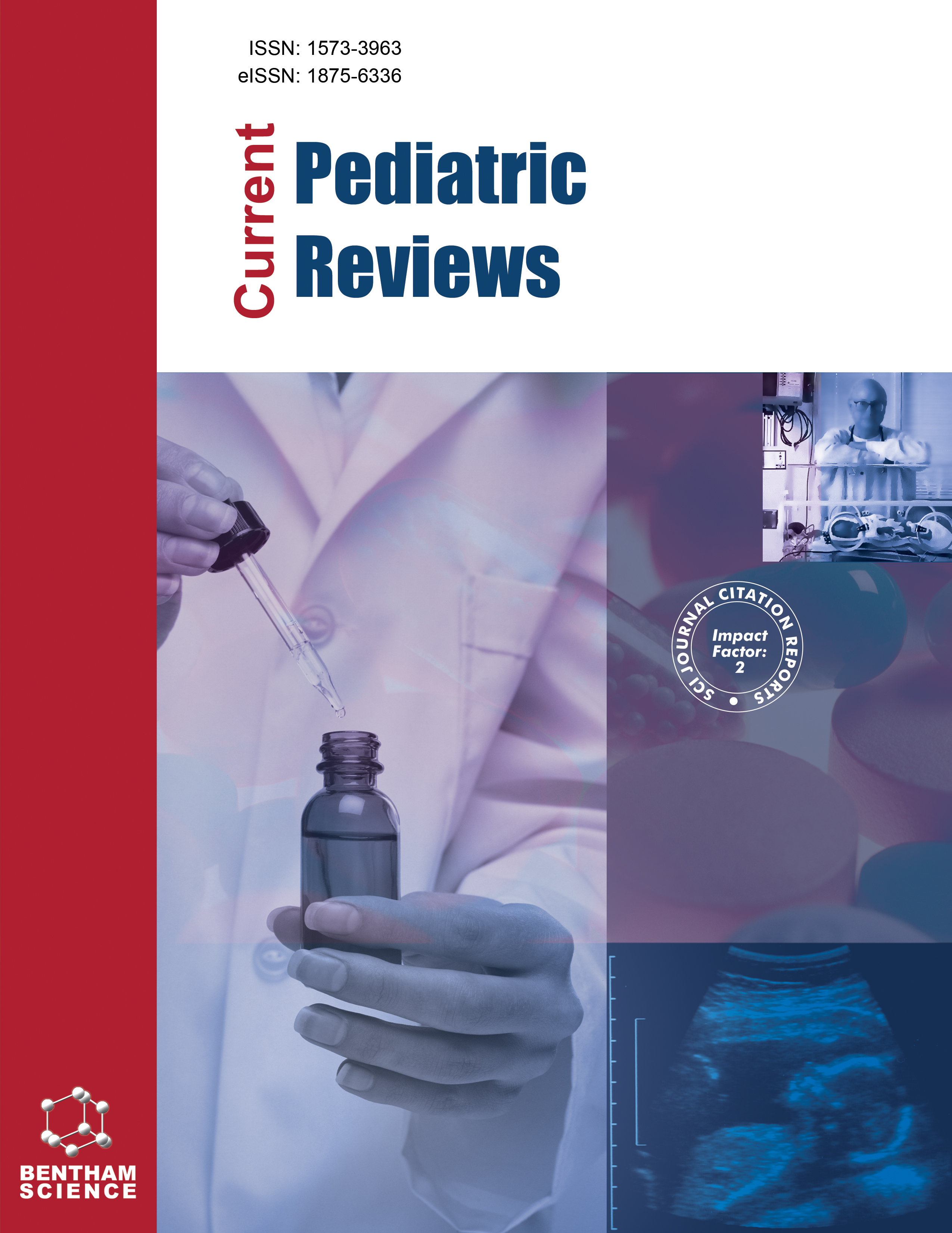- Home
- A-Z Publications
- Current Pediatric Reviews
- Previous Issues
- Volume 4, Issue 4, 2008
Current Pediatric Reviews - Volume 4, Issue 4, 2008
Volume 4, Issue 4, 2008
-
-
Recent Development in Neuronal Migration Disorders: Clinical, Neuroradiologic and Genetics Aspects
More LessAuthors: Paola Iannetti, Alberto Spalice, Laura Papetti and Pasquale ParisiDisorders of neuronal migration are a heterogeneous group of disorders of nervous system development. One of the most frequent disorders is lissencephaly characterized by a paucity of normal gyri and sulci resulting in a “smooth brain”. There are two pathologic subtypes: classical and cobblestone. Classical lissencephaly results from an arrest of neuronal migration, whereas cobblestone lissencephaly results from over Read More
-
-
-
The Role of Hypocarbia in the Development of Cystic Periventricular Leukomalacia
More LessCystic periventricular leukomalacia (PVL) is one of the most severe and frequent cause of cerebral palsy in children surviving preterm birth. The pathogenesis of PVL yet is not completely understood. The majority of the theories consider the necrotic foci to be hypoxic-ischemic lesions, resulting from impaired perfusion at the vascular border zones between ventriculopedal and ventriculofugal arteries, as the latter are p Read More
-
-
-
Pediatric Chronic Daily Headache
More LessChronic daily headache (CDH) affects 2 to 4% of adolescent females and 0.8 to 2% of adolescent males. Chronic daily headache is diagnosed when headaches occur more than 4 hours a day, for greater than or equal to 15 headache days per month, over a period of 3 consecutive months, without an underlying pathology. It is manifested by severe intermittent headaches, that are migraine-like, as well as a chronic baseline Read More
-
-
-
Long-Term Psychosexual Development in Genetic Males Affected by Disorders of Sex Development (46,XY DSD) Reared Male or Female
More LessAuthors: Amy B. Wisniewski, Katherine D. Kirk and Kenneth C. CopelandThe medical, surgical and psychosocial management of individuals affected by disorders of sex development (DSD) is currently under scrutiny. Patients who possess a 46,XY chromosomal complement (i.e., those affected by 46,XY DSD) pose particular challenges to healthcare professionals because this group is most likely to report dissatisfaction with their sex of rearing as they progress from childhood through adulthood. T Read More
-
-
-
Epidermolysis Bullosa: The Pediatrician's Role
More LessAuthors: Irene Lara-Corrales and Elena PopeEpidermolysis bullosa (EB) refers to a group of genodermatoses that present with skin fragility. Patients with this condition present life-long blistering and bullae formation in their skin and mucosal membranes as a response to minor friction or trauma. A revised classification has recently been published and three major types of EB we are identified: simplex, junctional and dystrophic. In each of these subtypes a spectrum Read More
-
-
-
Natural Rubber Latex Allergy in Pediatric Patients
More LessAuthors: Reinhold Cremer, Hans-Peter Rihs and Monika Raulf-HeimsothDuring the last fifteen years better hygienic standards led to an increased consumption of natural rubber latex (NRL) gloves for the protection of medical staff. At the same time case reports about an IgE-mediated allergy to NRL sometimes causing life-threatening anaphylactic reactions came up. This allergy was different from the well-known type IV reactions caused by latex additives. Health care workers and patients with mul Read More
-
-
-
Pediatric Eosinophilic Esophagitis: Epidemiology, Diagnosis and Treatment
More LessAuthors: James P. Franciosi, Terri Brown-Whitehorn and Chris A. LiacourasEosinophilic esophagitis (EoE) is a disease based on a clinico-pathologic diagnosis which involves a localized eosinophilic inflammation of the esophagus. There has been a significant increase in the incidence of diagnosis of pediatric EoE over the past 10 years due, in part, to a greater recognition of the disease among gastroenterologists, allergists and pathologists. EoE is defined by the presence of 15 or more eosinoph Read More
-
-
-
Economic Evaluation in Paediatric Practice: Examples from Cardiac Critical Care
More LessThe National Institute for Clinical Excellence (NICE) uses economic evaluation as the means to assess new treatments: this is a process unfamiliar to many clinicians. High technology treatments used in paediatric intensive care are expensive and have been subject to economic evaluation. A systematic review of the literature was performed for economic evaluations of treatments used for critically ill children with cardio-pulm Read More
-
-
-
Kingella kingae: A Pediatric Pathogen of Increasing Importance
More LessAs the result of the use of blood culture vials for seeding joint and bone exudates, and nucleic acid amplification methods, Kingella kingae is emerging as an important pathogen in patients <3 years of age. The organism is carried asymptomatically in the oropharynx of young children, coinciding with the age of increased attack rate of invasive disease, and propagates through close personal contact. Carriage of K. king Read More
-
Volumes & issues
-
Volume 21 (2025)
-
Volume 20 (2024)
-
Volume 19 (2023)
-
Volume 18 (2022)
-
Volume 17 (2021)
-
Volume 16 (2020)
-
Volume 15 (2019)
-
Volume 14 (2018)
-
Volume 13 (2017)
-
Volume 12 (2016)
-
Volume 11 (2015)
-
Volume 10 (2014)
-
Volume 9 (2013)
-
Volume 8 (2012)
-
Volume 7 (2011)
-
Volume 6 (2010)
-
Volume 5 (2009)
-
Volume 4 (2008)
-
Volume 3 (2007)
-
Volume 2 (2006)
-
Volume 1 (2005)
Most Read This Month
Article
content/journals/cpr
Journal
10
5
false
en


